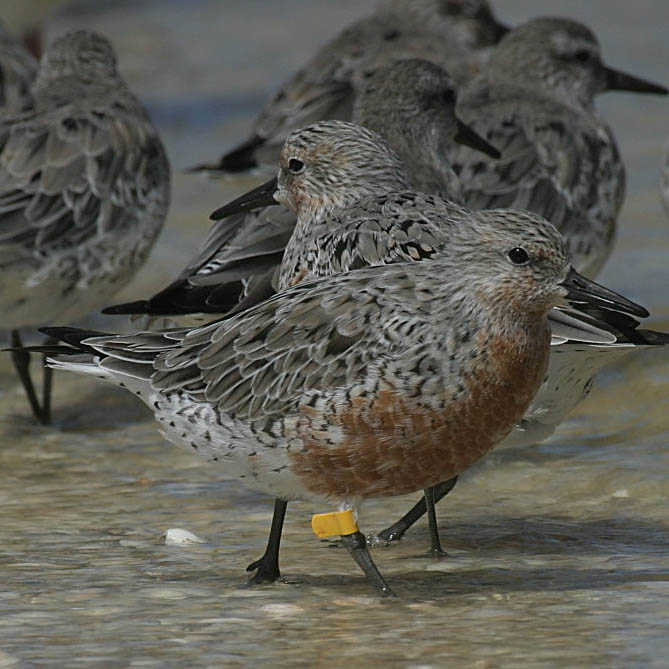
This article appeared in the February 2008 issue of Miranda News. It may not be reproduced without permission. Author, Gillian Vaughan.
Over the years there has been a lot of mention in our magazine of the various banding projects taking place in New Zealand and along the Flyway.
We’ve tried to keep people in touch with these programmes because if more people are on the look out for bands and flags, then more information comes back, and the more sightings that are recorded, the more valuable the projects become.
One of the consequences of having bands on birds is we get a number of people coming into the Shorebird Centre saying they have seen a green band on a Wrybill, and asking what that means.
Seeing just one band can mean a lot or it can mean nothing, it depends on the project. This article puts together the details on how much you need to see to know what it means! Having a little information about the birds you are looking at can add interest to your birding – and make you sound impressive to those standing around you.
Arctic Migrants
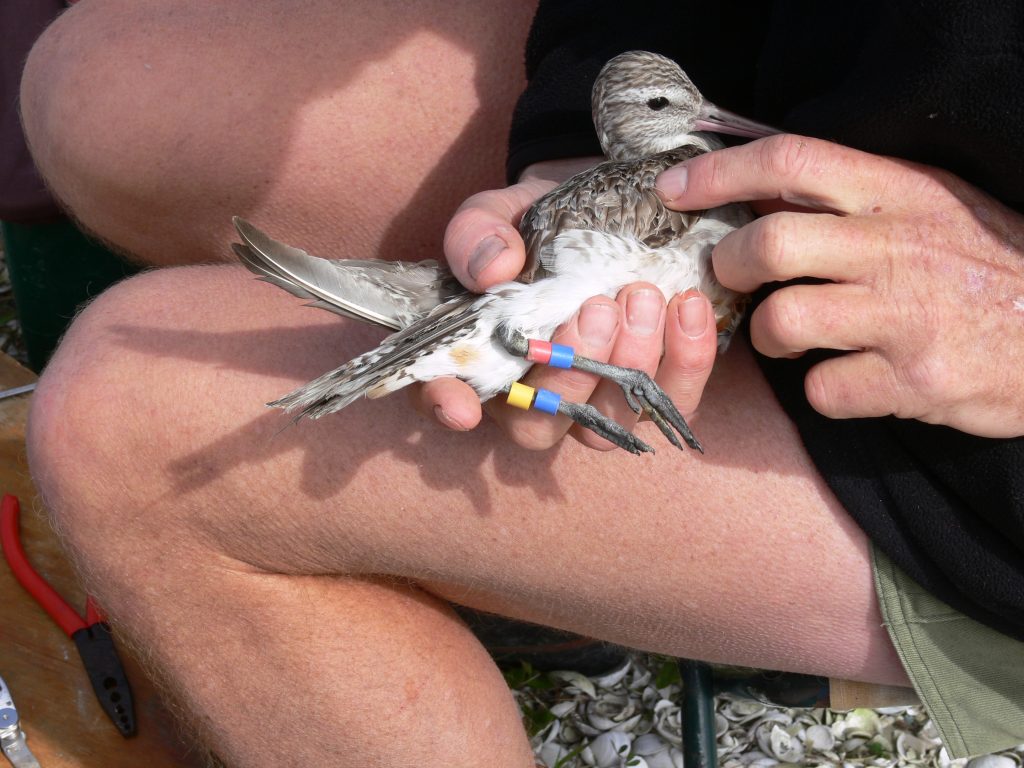
There are two main schemes involving the Arctic migrants: flagging and colour banding.
Flagging
The biggest programme on the Flyway has been the flagging of the Arctic migrants. For these birds you need to see if there is one flag or two, and what colour they are. This will indicate where that bird was banded and flagged.
Most of the time the flag or flags are on the upper part of the bird’s leg (the tibia). Where there are two flags they will usually both be on the tibia, but sometimes the second flag is on the lower part of the leg (the tarsus). Many of the different combinations in use are listed in the box below. You’ll note that all of the locations shown in the list are in the East-Asian Australasian Flyway. Other Flyways also run flagging programmes, so if you see a familiar looking flag when in South America or England, it will mean something else.
Recording the number of birds in a flock that were banded in other countries will, over time, allow for the discovery of main stop-over sites, the amount of movement between non-breeding sites, and show us the relationship between the breeding and non-breeding areas. The NZ Wader Study Groups newsletter publishes the detail on these on a periodic basis.
More recently many sites have started engraving numbers and letters on the flags, these identify individual birds. However to know which individual, you need to see the species, the flag colour and all the letters on the flags then send them in to be recorded (see addresses at end of article). NZ birds have white flags engraved with three black letters on the flags, those with black engraved flags have a white letter and a number. Most of the overseas programmes have either a letter and a number or two letters.

Colour Banding
In the last few years Bar-tailed Godwits, Red Knots and Turnstones have been banded with unique colour band combinations. Until recently this occurred only in NZ, however a similar project started about two years ago in North West Australia. There are four colours and a flag in each combination. The colours used in NZ are red, blue, white and yellow with a white flag. NW Australia is using red, blue, yellow and lime green with a yellow flag.
To know which bird you are seeing you need to know each band and the location of the flag. Colour bands are read left to right (the birds left and right!) and top to bottom, the flag can be above the ‘knee’ on either leg, below the ‘knee’ but above the bands or between the bands (see illustration). Be careful with the whites and yellows as some of the whites become stained; if you aren’t sure if its white or yellow write that down! You’ll need to report these to get the details about the individual bird.
In general birds with a flag on the left leg were banded in the South Island, those with the flag on the right were banded in the North Island. Most (but not all!) of the birds banded around Auckland have a flag on the upper part of the right leg, position 2.
A different colour banding project was run in North West Australia for several years where Arctic migrants of a known age were given a single colour band instead of a flag. Different ages were given different colours, this project has finished, and there are only a few records in NZ, however keep your eyes open for a bird with a single red, white, yellow, dark green or light blue colour band
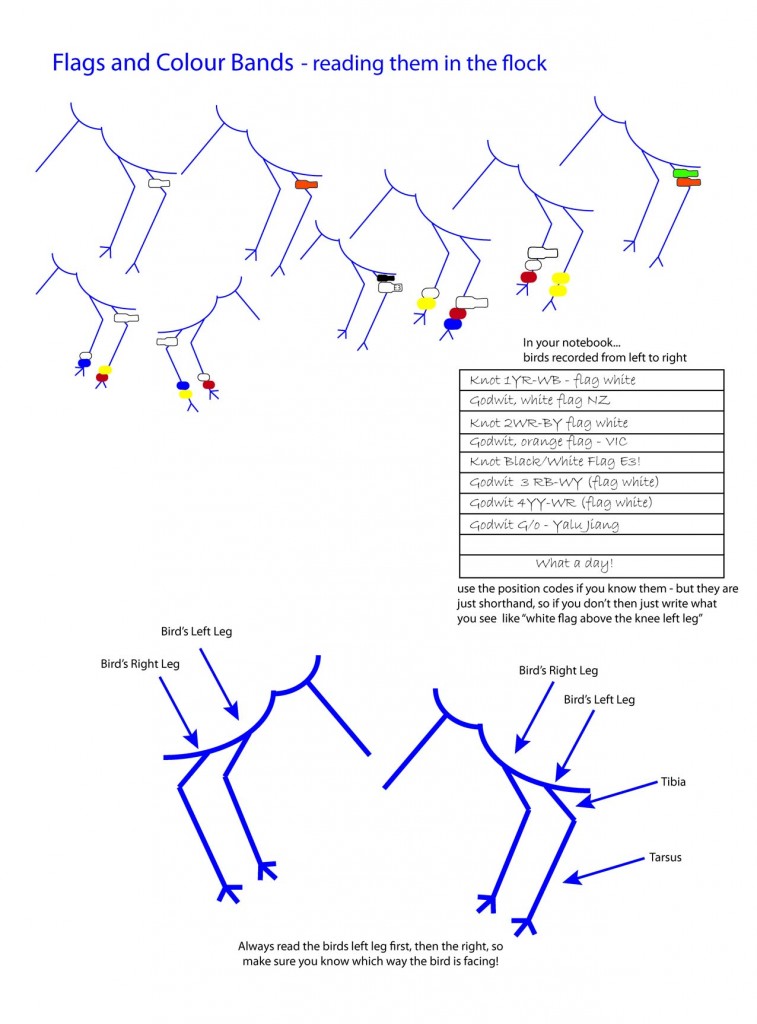
NZ Locals
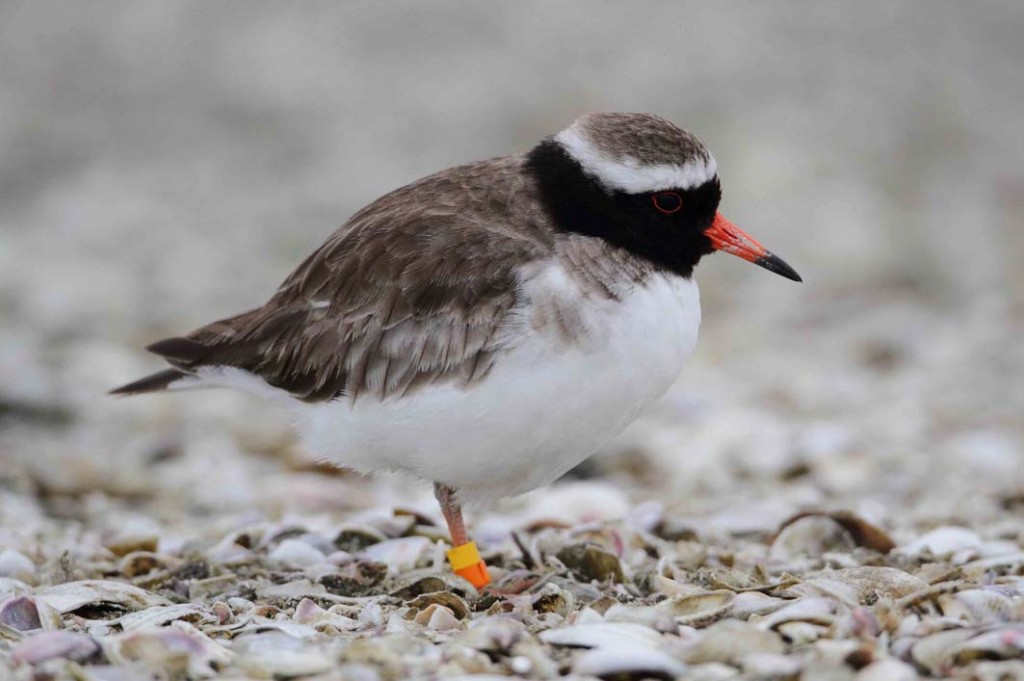
South Island Pied Oystercatchers
SIPO with a white flag were banded in the Firth of Thames, if they sport a plain yellow flag they were banded in the Kaipara – not North West Australia! If they are carrying an engraved yellow flag on the right leg they have been caught in the Nelson area since 2008. There are also a number with colour bands, banded as part of a small study down in Canterbury.
Wrybills
Wrybills have been colour banded on the breeding grounds, they can have three colours and a metal or four colours, if they have three colours on one leg the other leg only has a metal on it. If the combination doesn’t have an orange band the bird was probably banded in the last three years. Other than that if you want to know the details of the bird you’ve seen you’ll need to report the combination.
Black Billed Gulls
| Colour Combination | Summer the bird was banded | Location the bird was banded |
| Y – M* | 94/95 | Manukau |
| M – G | 95/96 | Firth of Thames |
| GM – Nil | 96/97 | Firth of Thames |
| R – M | 96/97 | Kaipara |
| Nil – GM | 97/98 | Firth of Thames |
| M – R | 97/98 | Kaipara |
| Nil – RM | 98/99 | Kaipara |
| R – RM | 99/2000 | Kaipara |
| G – M | 2000/01 | Firth of Thames |
| RM – R | 2000/01 | Kaipara |
| M – Y | 2001/02 | Manukau |
| YM – Nil | 2002/03 | Firth of Thames |
| YM – Nil | 2003/04 | Mataitai |
Around the Firth of Thames there are two groups of colour banded Black-billed Gulls. Those that have only one colour and a metal band are banded as chicks; only chicks hatched from that site in that year have that combination. Those with a green band were hatched in the Firth, those with a yellow band were hatched in the Manukau (except for YM-nil which was a combination used twice in the Firth). Birds with a red band or bands were hatched in the Kaipara. By getting a look at both legs you can see how old the bird is and where it was banded.
There are also individually banded birds, marked as part of an ongoing study looking at mate selection. These have three colour bands and a metal band (two colours on one leg and a colour and a metal on the other). If you see one of these during the spring and early summer see if it has a banded mate, if not it has probably changed mates since it was originally banded.
Black-billed Gulls in the South Island have also been colour banded, again different codes have been used for different ages.
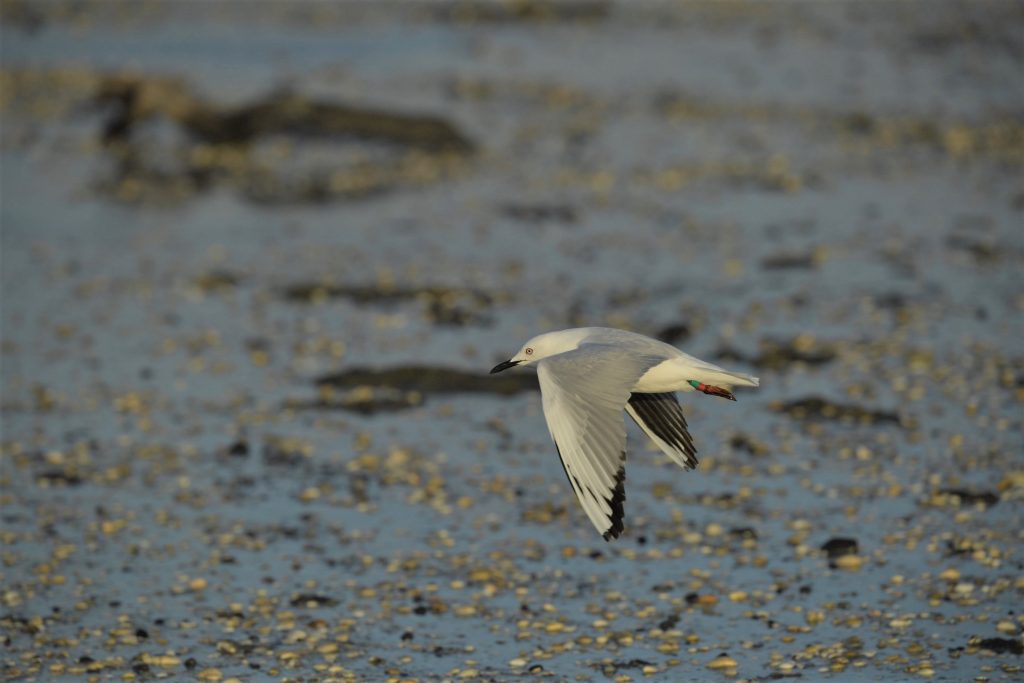
NZ Dotterel
Many NZ Dotterel have been individually colour banded as part of monitoring the population. Like Wrybill they can have 3 or 4 bands and the number on each leg can vary. Occasionally you will see one with a flag and no colour bands; these are flagged as part of year groups down in Tauranga Harbour.
Other NZ Species
There are colour bands on a number of other species, Banded Dotterel, Variable Oystercatcher, and Fairy Terns among others. Some Banded Dotterel also have Australian flags as some migrate their each year.
Reporting Colour Bands and Flag Sightings
So what do you do if you see something – well first you enjoy it! The bird has been somewhere and whether it was banded here or somewhere else its telling us something about how that species works, it’s part of the big picture and deserves a little appreciation! Work out what you can see already, does what you see tell you anything or do you need to see more to get the complete picture? Then we hope you’ll report your sighting.
Flags and bands can be reported to the Banding Office, they can also be sent directly to the people running each project.
Report flag sightings to Adrian Riegen riegen@xtra.co.nz
Report colour band combinations to Phil Battley in the North Island p.battley@massey.ac.nz and in the South Island to Rob Schuckard rschckrd@xtra.co.nz
Report Wrybill, NZ Dotterel and Variable Oystercatcher bands to John Dowding jdowding@xtra.co.nz
Report Black-billed Gull bands to Tony Habraken familyhabraken@yahoo.com.au
The Banding Office can be contacted at bandingoffice@doc.govt.nz
If you’re not sure where to send a sighting ask at the Shorebird Centre and we should be able to point you in the right direction admin@shorebirds.org.nz
The most common flags seen in NZ
| One Flag | Two Flags | But there are more! You can also look for these flags |
|---|---|---|
| White – NZ, North Island | Black over White – Chongming Dao Island China | Yellow band over Green flag – Alaska |
| Orange – Victoria | White over Black – Chongming Dao Island China (not used anymore, but some are still out there) | Green flag over Yellow band – Alaska |
| Yellow – North West Australia | White over Green – South Island NZ | Pale Blue – Northern Chukotka Russia |
| Green – Queensland | White over Green – South Island NZ | Pale Green – Southern Chukotka Russia |
| Blue – Northern Japan | Orange over Green – New South Wales | Blue over White – Central Japan |
| Black flags – used for birds with transmitters from NZ or Alaska | Orange over White – Korea | Yellow over White – Sakhalin Island Russia |
| White over Orange – Korea (also not used anymore, but some are still out there) | Pale Blue over White – Wrangel Island Russia | |
| Green over Orange – northern yellow sea (Yalu Jiang) | Yellow over Black – Kamchatka Russia | |
| Yellow over Orange – Southwest Western Australia | White over Blue – Taipei | |
| Orange over Yellow – South Australia | Blue over Blue – Northern Japan | |
| Orange over Blue – Tasmania | ||
| Blue over Orange – Southern Japan | ||
| White over Yellow – Hong Kong China | ||
Many of this group have never been seen in NZ, you could be first! |
